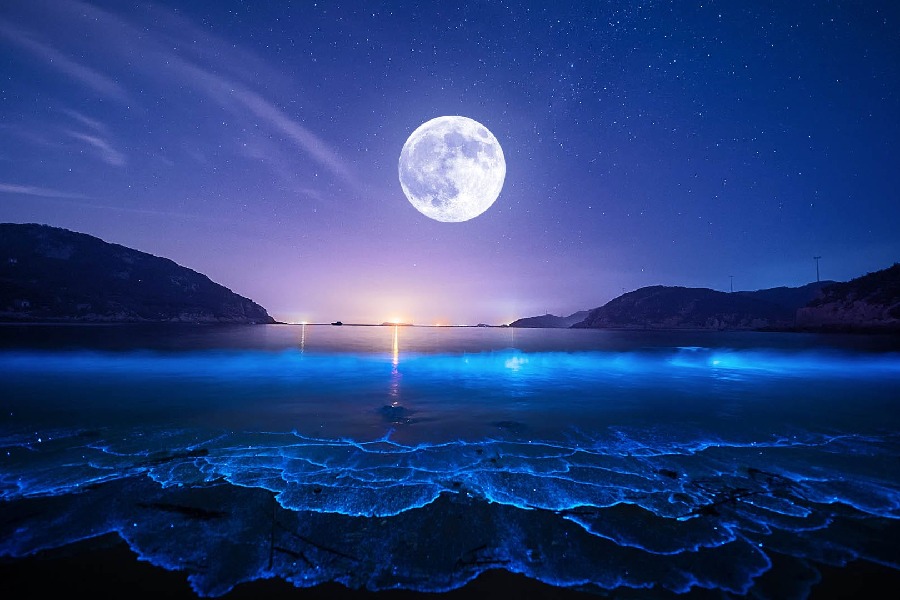Gazing up at the night sky has long been a source of wonder and fascination for humanity. Among the myriad celestial phenomena that captivate our imagination, few are as mesmerizing as the Supermoon. But what is a supermoon, and what causes this celestial marvel?
In this article, we’ll embark on a fascinating journey to unravel the mystery behind the supermoon. We’ll explore the perfect alignment of cosmic factors that give rise to this extraordinary event, transforming our familiar lunar companion into a breathtaking spectacle.
Learn what combination of factors comes into alignment to create a supermoon. Also, gain insight into the tidal impacts down here on Earth as ocean waters respond to this cosmic dance.
So, join us as we unlock the mysteries of the supermoon!

What Is a Supermoon?
A supermoon occurs when the full moon coincides with its closest approach to Earth in its orbit, known as the perigee. This proximity makes the Moon appear larger and brighter in the sky than usual.
It’s a spectacular celestial event that captivates observers with its enhanced size and luminosity. Supermoons occur periodically throughout the year, providing stargazers with an awe-inspiring display of the moon’s beauty and grandeur against the backdrop of the night sky.
What causes a supermoon?
The Moon travels around Earth in an elliptical or oval-shaped orbit. This causes its distance from Earth to vary over its monthly cycle. At one point, the Moon reaches its closest approach to Earth, known as perigee. The Moon is called a supermoon when it becomes full while at or near this closest point.
During a supermoon, it appears much bigger and brighter in the night sky. This is because it is some 30,000 miles closer to us than when it is farthest away in its orbit. The increased proximity makes the moon look 10% larger and 30% brighter than an average full moon.
In essence, a supermoon occurs when a full moon phase coincides with the moon’s most proximate point to Earth in its monthly orbit. This close alignment dramatically magnifies the Moon’s apparent size and brightness as viewed from our planet.
The average distance and size increase
The Moon orbits an average of 239,000 miles from Earth. However, its distance varies by about 30,000 miles due to its elliptical path. At perigee, its closest point, the Moon reaches as near as 221,000 miles away.
During a supermoon, the moon appears up to 14% larger than an average full moon. While this may seem small, it looks quite noticeable in the sky. It is analogous to a 9-inch pizza compared to an 11-inch pizza. A 14% larger size reflects over 30% more light down at us.
So, the moon’s already immense presence swells in visual width and brightness by over 10% during a supermoon, thanks to its closer proximity. This pushes it past the threshold most can perceive, eliciting gazes skyward to admire its magnified glow. A few ten thousand miles difference is enough for our nearest neighbor to put on a stellar show.
Types of Supermoons
As mentioned, a supermoon, technically termed a perigee-syzygy moon, happens when the Moon is at or near its closest point to Earth during a new or full moon phase. The full moon, particularly when aligned with the perigee, is the most striking supermoon, appearing fully illuminated, noticeably larger, and brighter.
Even a new moon can create a supermoon, but observing the enlarged dark moon is challenging. There are also crescent supermoons, partially aligned and enhanced in appearance.
Supermoons can occur randomly throughout the calendar year. Occasionally, consecutive full moons coincide with perigee, resulting in consecutive visually striking displays.
Although full supermoons attract considerable attention, any moon phase near perigee qualifies as visually larger. This unique alignment makes them captivating sights for astronomy enthusiasts.
Characteristics of Supermoons
Supermoons appear about 14% wider and 30% brighter than average full moons. Their exceptional size and luminosity are eye-catching sights. The increased gravitational pull can raise tides slightly, although most coastlines only see minor tidal changes. But how often does a supermoon occur?
On average, supermoons grace our skies around three to four times a year, offering a celestial treat for moon enthusiasts. However, the frequency of supermoons can vary from year to year.
Supermoons are more impressive visually than physically. Their immense, glowing orb has culturally captivated humanity for ages, featured in ancient legends, artworks, and traditions celebrating the Moon’s magnified magic.
Today, supermoon events draw crowds seeking to admire and photograph the Moon’s temporarily transformed state. It appears bigger and brighter than a typical full moon. This is thanks to its closer alignment with Earth.
Conclusion
What is a supermoon? The supermoon, an awe-inspiring celestial event, occurs when the full moon coincides with its closest approach to Earth, known as the perigee.
This alignment makes the Moon appear larger and brighter in the night sky, captivating observers with its enhanced size and luminosity. Supermoons occur periodically throughout the year, typically around three to four times annually, although this frequency can vary.
Despite minor tidal changes, supermoons offer a visual spectacle, drawing crowds of enthusiasts and photographers to admire the moon’s temporarily transformed state. With its cultural significance spanning ancient legends to modern-day traditions, the supermoon continues to fascinate and inspire wonder among humanity.
